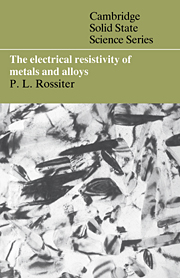Book contents
- Frontmatter
- Contents
- Preface
- 1 Basic concepts
- 2 Atomic configuration of an alloy
- 3 The structure of magnetic materials
- 4 Electrons in simple metals and alloys
- 5 Electrical resistivity of simple metals and alloys
- 6 Non-simple, non-magnetic metals and alloys
- 7 Magnetic and nearly magnetic alloys
- 8 Other phenomena
- Appendices
- References
- Index
8 - Other phenomena
Published online by Cambridge University Press: 07 January 2010
- Frontmatter
- Contents
- Preface
- 1 Basic concepts
- 2 Atomic configuration of an alloy
- 3 The structure of magnetic materials
- 4 Electrons in simple metals and alloys
- 5 Electrical resistivity of simple metals and alloys
- 6 Non-simple, non-magnetic metals and alloys
- 7 Magnetic and nearly magnetic alloys
- 8 Other phenomena
- Appendices
- References
- Index
Summary
In this final chapter, three other aspects of the resistivity of metals and alloys will be discussed. As with many of the topics included in this book, each of these could easily justify a complete text in its own right and so the discussions here will be of necessity rather brief. It is hoped, however, that this introduction to these topics, all of which are still in a state of development, will serve to assist the interested reader in pursuing the matters in more detail.
Resistivity at the critical point
Some general comments
As noted in Chapter 2, a second order phase transition is characterised by a long range order parameter that continuously decays to zero as the critical transition temperature Tc is approached. Any of the physical properties of such a system which depend upon the derivative of S (or M) with respect to temperature, dS / dT (or dM//dT), such as the specific heat or temperature coefficient of resistivity dp/dT, will diverge at Tc. However, this gives a static picture of the transition which is somewhat misleading. Near Tc, small fluctuations in temperature produce fluctuations in the correlation parameter that are large in both magnitude and spatial extent. Since the resistivity is proportional to the magnitude of such correlations (the subject of Chapters 5 and 6), it is expected that the detailed behaviour at the critical point will be determined by these fluctuations.
- Type
- Chapter
- Information
- The Electrical Resistivity of Metals and Alloys , pp. 356 - 392Publisher: Cambridge University PressPrint publication year: 1987



